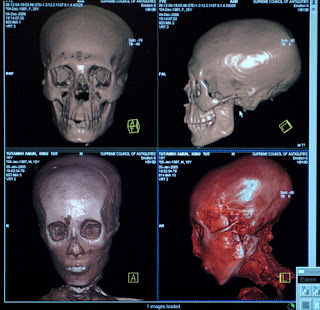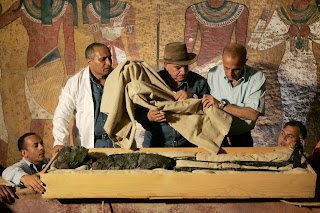In the year 2005, (more than 3,300 years after his death), King Tut's mummy became one of the first mummies to undergo a CT scan- "in death, as in life, moving regally ahead of his countrymen". The CT scan was led by Zahi Hawass and one with a portable CT machine. The scan came up with new clues about his life and death. It provided precise data for an accurate forensic reconstruction of King Tut. Due to sand in the cooler fan of the CT machine, they had to use two plastic fans to complete the scanning process.
Tut's body was examined over a computer screen with the help of the CT scan. It showed a grey head, neck vertebrae, a hand, several images of the rib cage and a transection of the skull. After collecting the data for scan, the Pharaoh is sent back to the place he belonged, i.e., his coffin. It was a relief for Zahi Hawass as "nothing had gone seriously wrong" with the mummy.
After his observation, when they left, the wind had stopped and the surrounding came to a deathly silence. In the sky, just above the entrance to Tut's tomb stood Orion, the constellation , also called by
the Egyptians as the soul of Osiris, the god of afterlife, watching over the boy king.
 |
| Tut's Scanner Result |
 |
| Examining Tut's body |
Tut's body was examined over a computer screen with the help of the CT scan. It showed a grey head, neck vertebrae, a hand, several images of the rib cage and a transection of the skull. After collecting the data for scan, the Pharaoh is sent back to the place he belonged, i.e., his coffin. It was a relief for Zahi Hawass as "nothing had gone seriously wrong" with the mummy.
After his observation, when they left, the wind had stopped and the surrounding came to a deathly silence. In the sky, just above the entrance to Tut's tomb stood Orion, the constellation , also called by
the Egyptians as the soul of Osiris, the god of afterlife, watching over the boy king.










